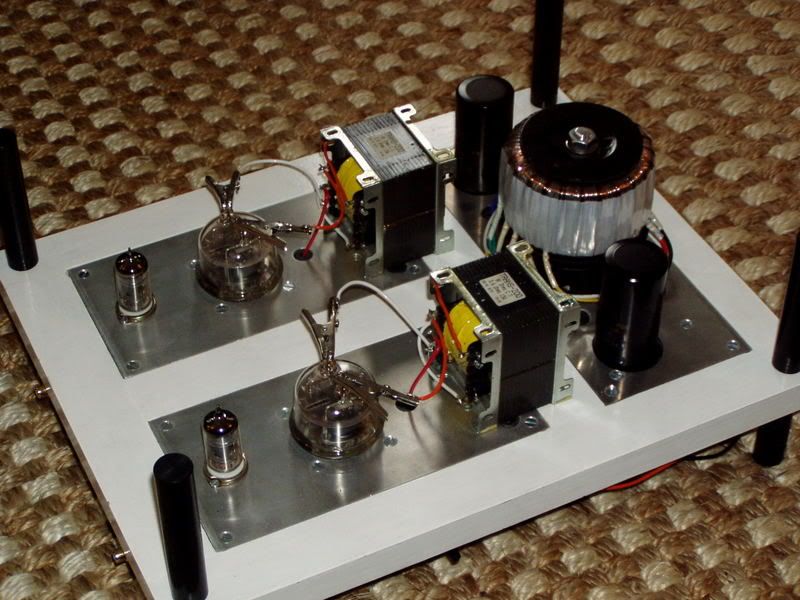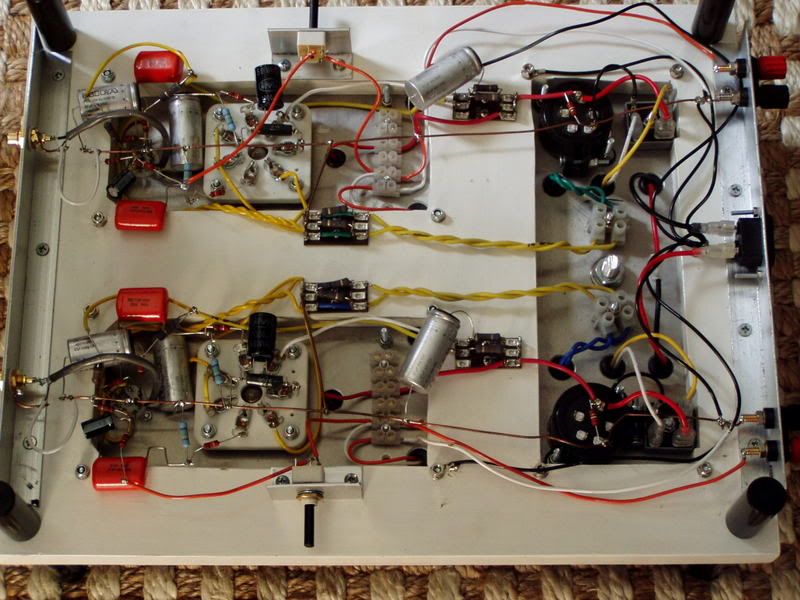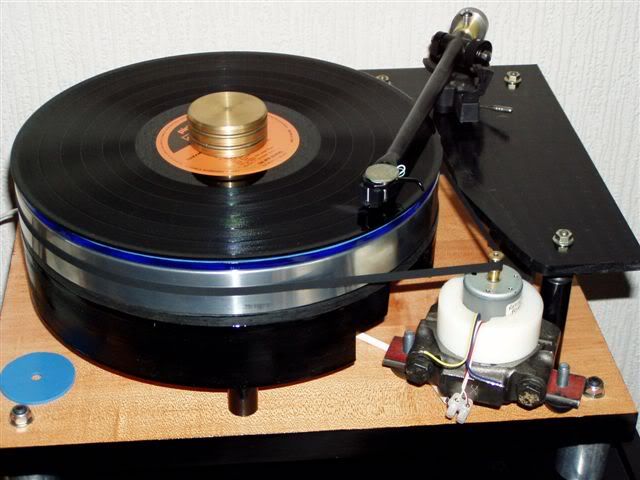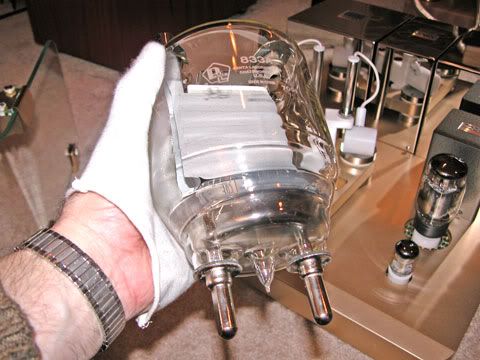|
|
Post by pre65 on Dec 30, 2015 13:51:29 GMT
My very first DIY amp build was therapy after my wife died in 2006.
It was a push pull design using an 832a trawler radio valve and a 12at7 driver/phase splitter. The design is published on the web, but I did make a few modifications of my own.
Here it is in version 2 with upgraded Audionote output transformers

I still have it, but it needs two new 832a valves and I've not got them yet.
Sound quality was quite good, much better than I might have imagined. Over the years there have been mods, notably a ccs in the cathode of each 832a and more recently an anode ccs for the 12at7a and a "simple" phase splitter. The power supply uses a single toroid with two secondarys, each secondary feeding one channel making it nearly dual mono.
|
|
|
|
Post by pre65 on Dec 30, 2015 14:19:31 GMT
Here is the underneath view of version 1. The switches on each side were feedback on/off, but as I decided they sounded better without feedback they were removed for version 2.
The delrin legs enabled the amp to be worked on upside down.

|
|
|
|
Post by John on Dec 30, 2015 16:17:03 GMT
Thanks for sharing Phil
|
|
|
|
Post by pre65 on Dec 30, 2015 16:31:13 GMT
|
|
|
|
Post by MartinT on Dec 31, 2015 10:51:21 GMT
What voltages are on those croc clips, Philip?
|
|
|
|
Post by pre65 on Dec 31, 2015 11:32:34 GMT
Only about 300v. 
I will say that I now use some proper insulated terminals.
Living alone (as I was then) with no pets or children to worry about it was expedient.
WARNING. DIY valve amps can be dangerous.
|
|
|
|
Post by pre65 on Dec 31, 2015 11:57:18 GMT
Slightly off topic, but here is a Lenco GL75 baseplate which I modified to use as a motor unit with separate arm plate.
The edge was cut off, and then the end strip bronze welded back on.

Although I experimented a lot with Lenco decks I ended up using a Garrard 401.
*
|
|
|
|
Post by pre65 on Dec 31, 2015 12:09:37 GMT
My second amp was inspired by good press from people using the PT15 valve. It had been said that a PT15 used as a triode was very similar to the fabled PX25, so it had to be done.
The two chassis (monoblocks) were made from 4" X 2" alloy angle with an alloy top plate. The PT15 was driven by a C3g using a gas regulator valve to stabilise the C3g G2. This was a James Doddington circuit, and a clever man he still is.
The light bulb was the PT15 cathode resistor. 

The amp is no more, but the chassis have been used for several different projects over the years, and now reside on top of the wardrobe.
*
|
|
|
|
Post by MartinT on Dec 31, 2015 12:35:56 GMT
Valves I've never heard of!
|
|
|
|
Post by pre65 on Dec 31, 2015 12:48:10 GMT
Valves I've never heard of!
The C3g was a high quality valve developed by Siemens for use in German telecommunication networks.
I'm not going to detail every valve amp I ever made, just the few that stand out.  |
|
|
|
Post by dsjr on Dec 31, 2015 13:07:41 GMT
Haven't you got some highly dangerous looking (and sounding?  )  mega amps around and about? I'm sure it was some of yours at a bakeoff/show not long ago and they were open-plan and rather humungous in valve and transformer complement. |
|
|
|
Post by pre65 on Dec 31, 2015 13:16:23 GMT
Haven't you got some highly dangerous looking (and sounding?  )  mega amps around and about? I'm sure it was some of yours at a bakeoff/show not long ago and they were open-plan and rather humungous in valve and transformer complement. I'll get round to them in due course.  I'm stuck in West Yorkshire at the moment, so relying on memory and my Photobucket archive. |
|
|
|
Post by pre65 on Aug 30, 2016 12:34:56 GMT

Not amps this post, but what got made from the bits of a Logic DM101 some years ago.
The motor is a high torque video motor, and is held in a white delrin case,and in turn held by an Iveco con rod standing on 3 rubber buffers.
Drive, as can be seen, was to the platter outer. The headshell is weighted,with an extra counterbalance weight to compensate, must have been a DL103 at the time.
I now prefer DD and ID types so anything belt drive is history. 
![]() |
|
|
|
Post by pre65 on Aug 30, 2016 12:47:35 GMT
I must get round to finishing off the 833a rebuild this autumn/winter.
For anyone not aware, this is an 833a. 
Not my photo, but it makes the point.
833a = metal anode and 833c = carbon anode. I have both. 

|
|
|
|
Post by MartinT on Aug 30, 2016 13:16:45 GMT
You need to be VERY careful with the HT to that valve! Pretty scary looking device, I must say. I like the work you did with the turntable, even if it is belt drive  |
|
|
|
Post by ChrisB on Aug 30, 2016 13:23:03 GMT
Wow - what were those valves designed to be used for originally? Not hifi amps, I bet!
|
|
|
|
Post by pre65 on Aug 30, 2016 13:30:56 GMT
Wow - what were those valves designed to be used for originally? Not hifi amps, I bet!
HT was about 950v on the last iteration, but with the new transformers I'm hoping for about 1300v (1.3Kv) 
Ideally the anode should have a small red spot. 
I'd like to try two of Rod Colemans 10v @5a (=10v @ 10A) filament modules on each valve, but that might be variation 2 for the project. |
|
|
|
Post by pre65 on Aug 30, 2016 13:32:44 GMT
You need to be VERY careful with the HT to that valve! Pretty scary looking device, I must say. I like the work you did with the turntable, even if it is belt drive  |
|
|
|
Post by MartinT on Aug 30, 2016 13:45:37 GMT
|
|
|
|
Post by Sovereign on Aug 30, 2016 16:19:38 GMT
Great thread Philip, I completely missed it. Glad it's resurrected its self
|
|